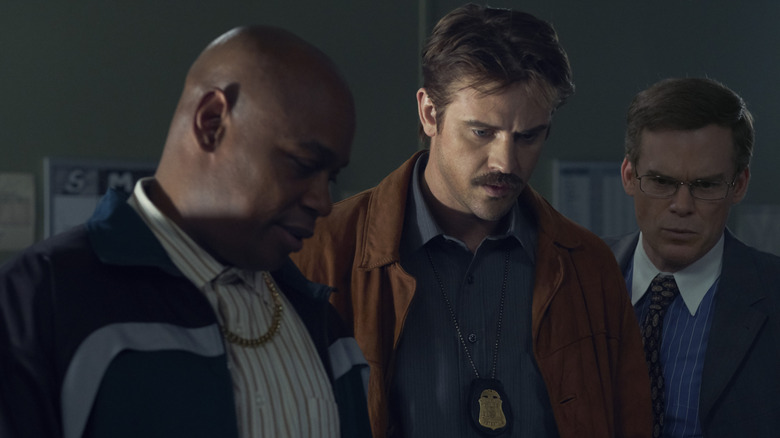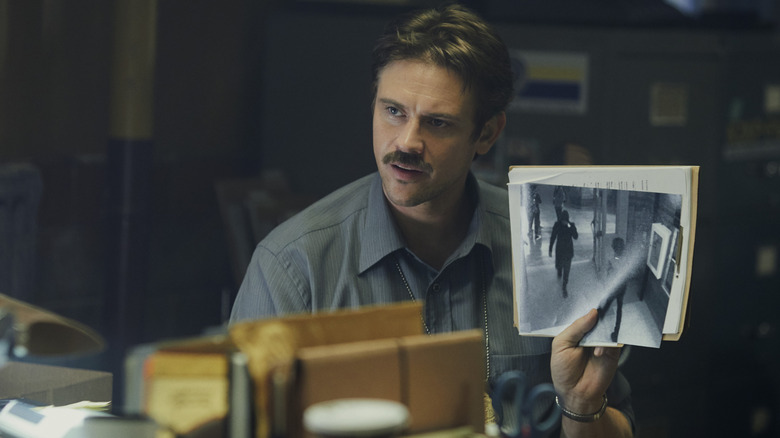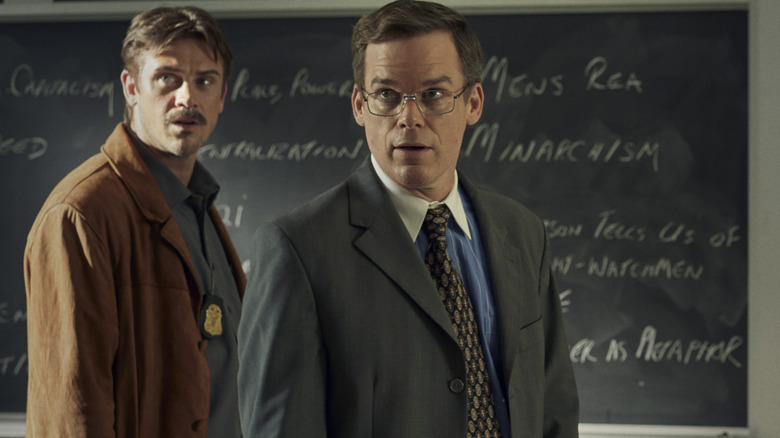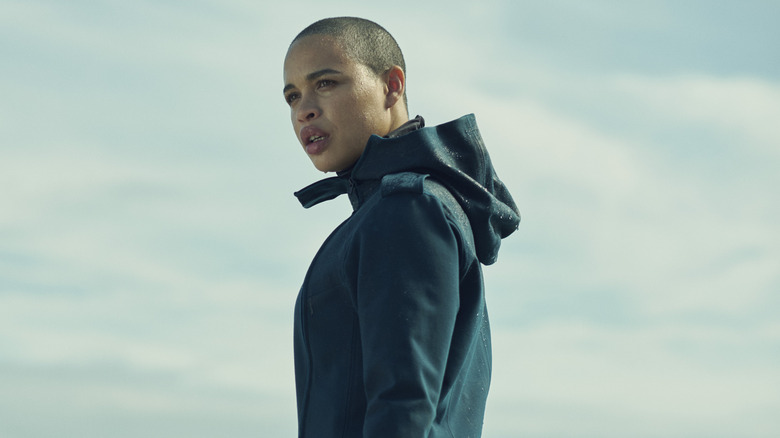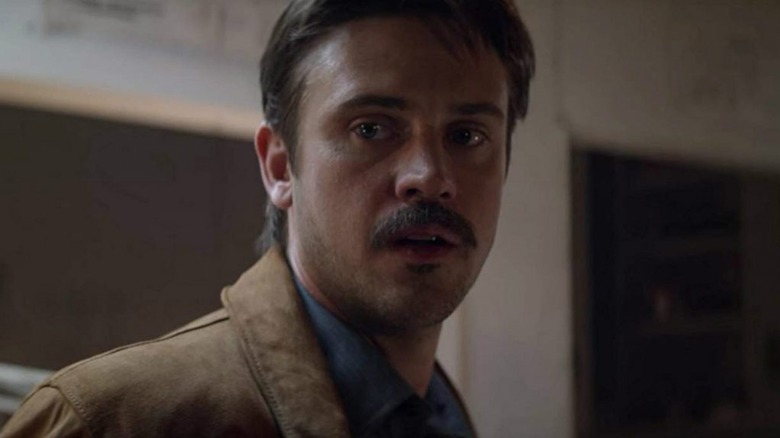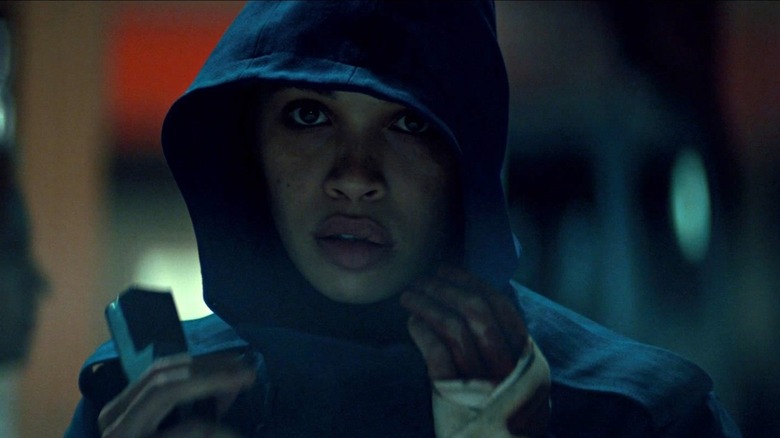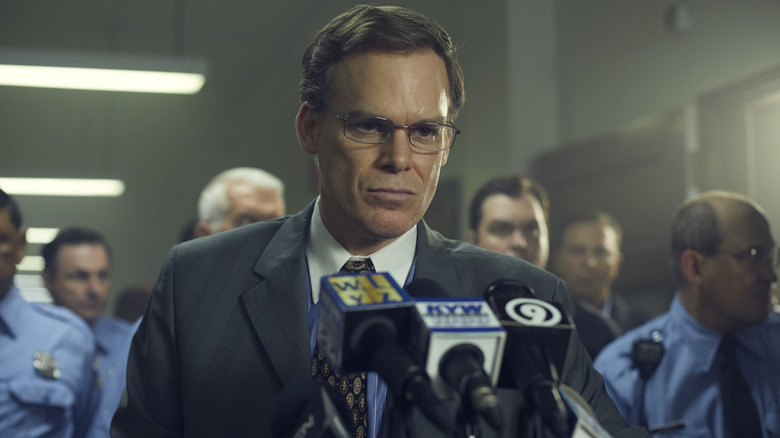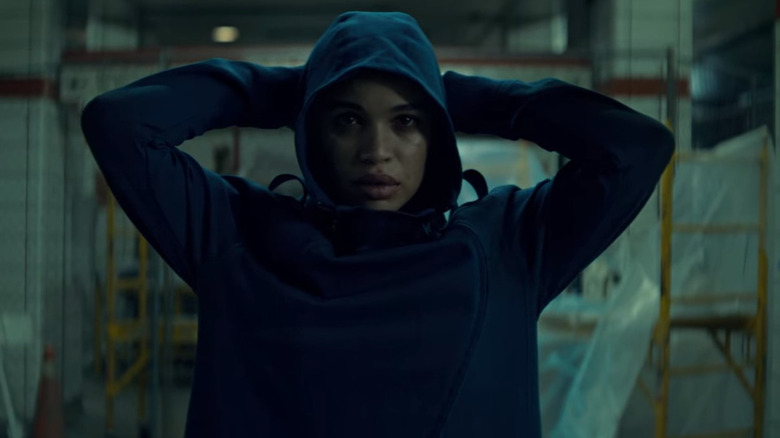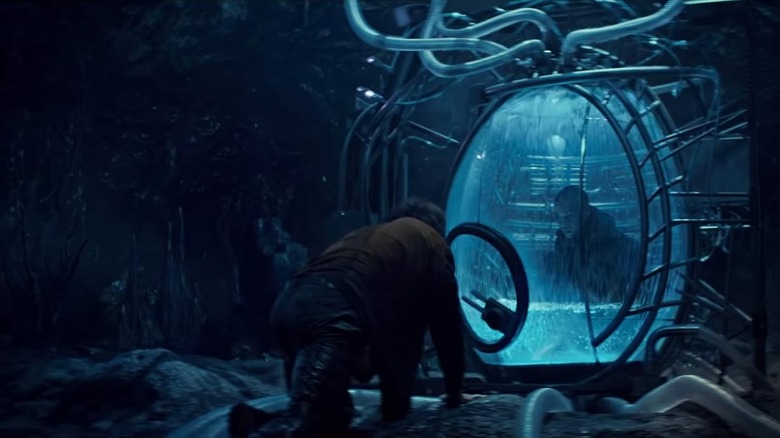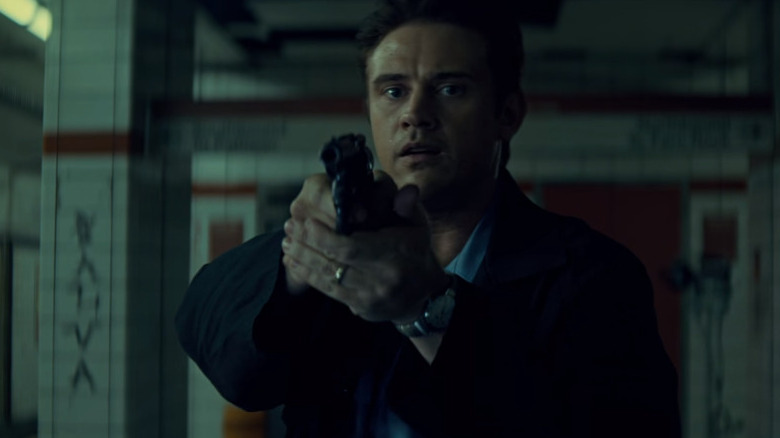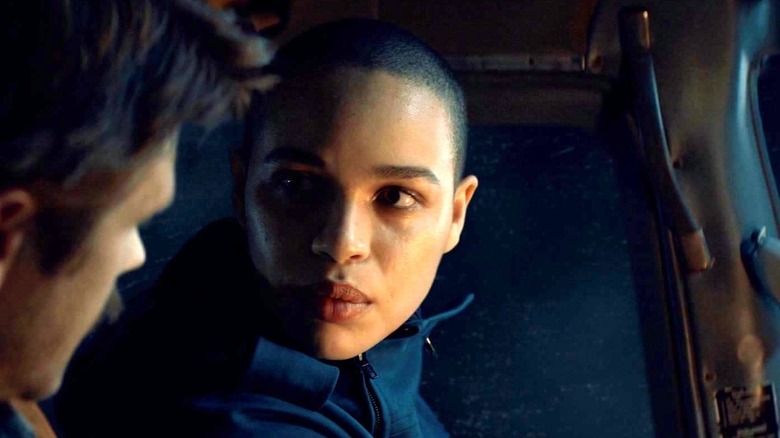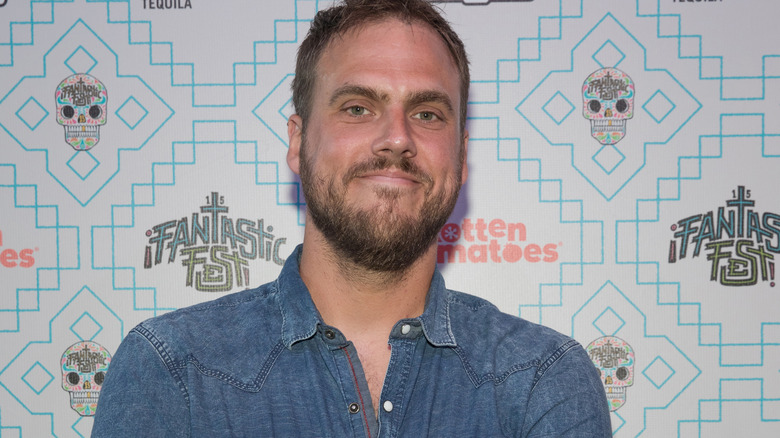The Ending Of In The Shadow Of The Moon Explained
"In the Shadow of the Moon" is a Netflix original movie, released in 2019, blending the detective-mystery genre with sci-fi in an expansive story that stretches from 1988 all the way into the future. One dogged investigator dedicates his life to catching a serial killer that everyone else believes to be dead and who we later learn is capable of traveling through time. The script was written by Geoffrey Tock and Gregory Weidman, a screenwriting duo who had previously collaborated on the TV shows "Zoo" and "Limitless," and directed by Jim Mickle — working with the first major budget of his career after directing low-budget horror flicks like "Stake Land" and "We Are What We Are."
The film has caused plenty of confusion in the four years since its release, but not all of it stems from where you might expect. Some of the confusion is owed to the complexity of the film's time travel plot and its five-decade-spanning narrative, but other confusion also stems from the film's screenplay shortcomings and a couple of glaring plot holes. Let's dive in and try to clear up the ending of "In the Shadow of the Moon."
What you need to remember about the plot of In the Shadow of the Moon
The film focuses on Locke (Boyd Holbrook), an ambitious police officer aspiring to become a detective. We see him reach that goal only to lose his job and become estranged from his family when his obsession with catching a presumed-dead killer takes over his life. He dedicates about 40 years of his life to this pursuit while those in his personal life gradually write him off.
The killer that Locke obsesses over is Rya (Cleopatra Coleman), who is active throughout each of the film's chapters despite appearing to die in the first one set in 1988. While the police suspect there is a copycat of the original killer, Locke knows that Rya is responsible — even though that would seem logically impossible. At first, Locke thinks she must not have really died in 1988, but he eventually discovers the truth: that Rya is utilizing time travel.
The first person who floated the idea of the moon allowing time travel once every nine years was Naveen Rao (Rudi Dharmalingam). Rao was written off at first, but Locke eventually realizes that he was correct all along and more deeply connected to the killer's use of time travel than even Locke was aware of at the outset. The other important character to remember in order for the ending to make more sense is Locke's daughter Amy, played by both Quincy Kirkwood and Sarah Dugdale at different ages.
Keeping the timeline straight
Keeping this complicated timeline straight is necessary to properly make sense of the plot. The film opens with a brief prologue set in 2024 before jumping back to 1988. At this point in time, Locke and his partner Maddox (Bokeem Woodbine) are both police officers who step outside their lanes, acting like detectives and investigating the work of a new serial killer. Locke and Maddox have their first encounter with Rya, which leads to her death. At the end of this chapter, Locke's daughter Amy is born, and sadly his wife dies during childbirth.
The film then jumps to 1997, when Locke and Maddox are both working as detectives, and the same serial killings begin again. After confronting Rya a second time, Maddox is killed, and Locke learns about Rya's time travel.
In 2006, Locke is now unemployed after his obsession with the killer sees him start to unravel. He attempts to kill Rya but only manages to shoot her in the hand. He chases her to her time machine but is too late. Nine years later, Locke is there waiting for her in 2015 when the time machine reappears, at which point he learns the details of her plan and that she is his eventual granddaughter and Amy's current unborn daughter. Though the year is not called out like in the other chapters, there are also glimpses of a time further into the future as Rao implements the time travel plan to send Rya back and execute people from the future — which we can assume takes place in or around 2033 based on Rya's age when she is sent back.
Understanding the flow of time
The most important detail of "In the Shadow of the Moon" is that Locke and Rya are not experiencing the flow of time in the same way. The film is told solely from Locke's perspective, and he experiences the story linearly — just as everyone else experiences time. Rya, on the other hand, experiences the events of the film in reverse chronological order and only in brief intervals. Her story begins in the future, presumably around the year 2033. In this film's reality, the ability to time travel is directly tethered to the moon, which puts tight restrictions on Rya. She can only progress backward in nine-year leaps and remain in the past for brief windows before returning to the time machine.
Each time Rya returns to the time machine, she is brought directly to the next nine-years-earlier destination without returning to the future in between, which means that the film's entire narrative happens on a drastically compressed timeline from her perspective. Since Locke and Rya experience time in opposite ways, the things Locke does in the future affect the Rya he already saw in his past. For example, the wound Rya has on her hand in 1988 and 1997 is caused by Locke shooting her in 2006. Similarly, in their first encounter (from Locke's perspective) in 1988, Rya appears to apologize for hurting Maddox in the fight they just had. However, she is actually apologizing for killing him in 1997, which just happened for her but won't happen for Locke until nine years later.
What happened at the end of In the Shadow of the Moon
The climax of "In the Shadow of the Moon" takes place in 2015 when Locke catches Rya at gunpoint on the beach just outside of her time machine. This is their fourth confrontation from Locke's point of view but only the first from Rya's perspective. Her mission has only just started even though Locke has already spent most of his life pursuing her.
Rya explains who she is and shows Locke a charm bracelet that she says belonged to her mother. This is the same charm bracelet that Locke had given to his daughter Amy, and he comes to the realization that the person he has been pursuing for almost 40 years is his own granddaughter. Rya explains the full scope of her plan, which involves killing the various people who planted the seeds that would eventually blossom into acts of domestic terrorism and lead to millions of deaths.
Locke hears Rya out and finally understands that she was telling the truth all those years ago when she told him that the killings were for the greater good. He also comes to learn that he is the one who eventually convinces her to take on the mission in the first place many years in the future.
What the ending of In the Shadow of the Moon means
The ending monologue means that Rya — who has been presented as the film's villain — is actually the hero. That doesn't make Locke a secret villain. His intentions are still good, but he is unknowingly working against his own best interests for the entire film and attempting to kill his own granddaughter without realizing it.
Though her actions at first appear to be those of a serial killer, Rya is actually risking her life to undertake a dangerous mission for the good of humanity. Her ultimate goal is to prevent the millions of deaths that result from the eventual domestic terrorism and a second civil war in the future. Even more importantly, Rya is successful in her mission. It is crucial to understand that the 2024 future shown at multiple points in the film does not come to be after Rya succeeds in her mission. The final glimpse of the post-civil-war U.S. is shown in reverse, with the flames of destruction receding as the course of history is altered for the better because of Rya's actions.
The victims were all connected
Throughout the 1988 and 1997 chapters of the film, Rya's various victims appear to be completely random. It is explained that the police spent time digging into the lives of each victim and were unable to find any concrete links between them all. To fully understand the plot of "In the Shadow of the Moon," it is important to grasp that the police were incorrect in those assertions.
As Locke later discovers, the victims are all connected. The victims were tethered together through a shared ideology and as part of a burgeoning, radical political group. Rya's mission is to take out those particular individuals because they are the ones who become active participants in the domestic terrorism and second civil war efforts or are the first to plant dangerous ideas in the heads of their family members, who in turn cause violence and civil unrest in the future.
The plot isn't as complicated as it seems
Because of its use of time travel, its diverging perspectives, and its segmented narrative spread across many decades, the plot of "In the Shadow of the Moon" seems extremely complex at face value. In truth, the plot is actually quite simple, it is just told in a complicated manner. When boiled down, the core story of the film is basically the same plot as the first "The Terminator" movie, where a killer is sent back in time to eliminate the mother of the future resistance leader. In Rya's case, she has several targets instead of just one. The other key difference is that the Terminator's goal was to wipe out the future resistance, whereas Rya's goal to wipe out the opposing side of the future civil war is framed as heroic rather than evil.
Though the narrative backbone isn't all that complicated when you get right down to it, there is still plenty of room for confusion within "In the Shadow of the Moon." Rather than being confusing due to its complexity, some of the confusion stems from the film's plot holes and its lack of consistent internal logic.
The time travel doesn't add up
If you already understand the plot and the distinction between how Locke and Rya experience time but still find yourself confused, then it might be time to accept one of the film's biggest flaws: The time travel in "In the Shadow of the Moon" doesn't make perfect sense.
Partway through the film, Locke realizes that Rya is moving backward through time. He hears this from her directly and has proof from the gunshot wound he gives her in 2006 being present in 1988 and 1997. Given that he fully comprehends this fact, it does not make sense that killing Rya continues to be his goal, because if he ever succeeded he wouldn't have met her in the past.
Rya explicitly says, "If it begins with you warning me here on this beach, then it always ends with me dying." If this statement is true, as it appears to be based on everything that already happened and will happen, then nothing Rya does in the past matters as the future is already set in stone, rendering her entire mission fruitless. At the same time, this cannot possibly be true because her plan works out in the end, meaning the film's internal logic contradicts itself. Additionally, Locke is the one who convinces Rya to go on the mission, but he only does so because of what she says to him on the beach in the past, which can't happen if he doesn't convince her to go on the mission, which can't happen without her already going on the mission, and so on and so forth creating a chicken-and-egg paradox.
The assassinations are over-complicated
One plot detail that is likely to confuse viewers is the fact that the murders committed by Rya are actually carried out from the future, technically. Rya needs to approach each target in the past and inject them, but the assassinations themselves are remotely triggered in the future by Naveen Rao. This is confusing for two reasons, both of which the film would rather you didn't think about.
The first is that Rya needs to inject each victim with her three-pronged device before the executions can be carried out simultaneously. In the first chapter, one victim calls the police to report her forced injection. However, there is no explanation given for why she isn't executed until later when everyone else was killed in sync, nor why the other victims didn't report being attacked and forcibly injected.
The second question left hanging: why is this overcomplicated assassination process necessary in the first place? The idea of executing targets from the future makes sense on paper, but it stops being logical when an individual needs to travel back in time and physically attack each target in order for the plan to work. This renders the future-trigger component of the assassinations completely pointless as Rya may as well just inject each target with normal poison or kill each target through any other means. It also doesn't make much sense that everyone responsible for the second civil war is centralized around Philadelphia for Rya to easily reach, but this is clearly a film that does not want viewers scrutinizing its plot too closely.
Making sense of Rya's actions
Rya's motives and methods remain elusive for much of the movie. Trouble arises when it turns out that her actions make even less sense once the truth is revealed at the end. There are many choices made by Rya that don't add up in retrospect or upon rewatch, the most glaring of which is her deliberate choice to withhold information from Locke.
The first time Rya speaks with Locke on the beach — which is their final encounter of the film from Locke's perspective — she explains everything, unveiling her plan, her justifications, her methods, the future she is trying to avert, and the fact that she is his granddaughter. Explaining everything ends up working perfectly as it diffuses Locke's desire to kill her and gets him on board with her plan. Since this easily solved her problems, it calls all of Rya's actions into question as she moves further into the past, where Locke is still trying to kill her.
Rya spends the rest of the film being intentionally vague and avoiding any straight answers with Locke, despite the fact that she already knows how to diffuse his desire to kill her and get him on her side instead. She has no reason not to give the same explanation each time they meet further back in the past, which would make her job infinitely easier. Her decision to only tell him the first time she meets him — again, which is the last time they meet from Locke's and the audience's perspective — only makes sense externally as a way for the film to save its big twist for the ending, making it perhaps the largest plot hole in a film with quite a few to worry about.
What has the director said about the ending?
Director Jim Mickel spoke at length about the ending of "In the Shadow of the Moon" after the film's premiere screening at Fantastic Fest. He explained that, for him, the film actually has two endings, but one of them is placed near the start. Since Locke and Rya experience the flow of time in opposite directions, the starts and ends of their character arcs land at different points in the story chronologically. The conclusion to Locke's story and character arc is placed right at the close of the film, where endings traditionally always are.
Rya, on the other hand, has her ending in the film's opening act. Her character arc ends with her death in 1988 while Locke's arc is just getting started. Conversely, her character arc begins on the beach in 2015, right where Locke's ends. Mickle explained to Collider that these diverging character arcs drew him to the script, saying, "Her story is backward, his story is forward. So the first time that they meet, it's his first time meeting her, it's her fourth time meeting him. And by the end of the story, it's his fourth time meeting her and it's her first time meeting him... that was actually the hook that got me."
